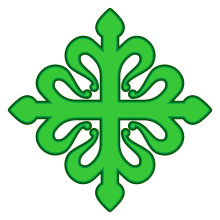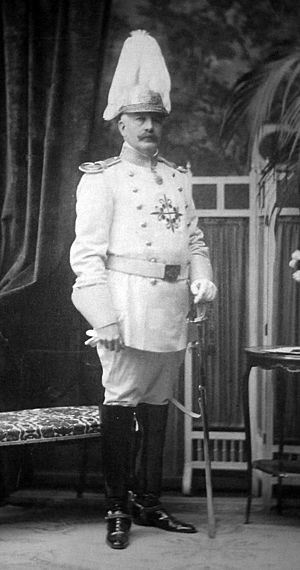Order of Alcántara facts for kids
Quick facts for kids Order of AlcántaraOrden de Alcántara |
|
|---|---|

The order emblem, a green greek cross in gules with fleur-de-lis at its ends
|
|
| Type | Religious Order of Honour and formerly a Military Order |
| Country | Spain |
| Royal house | House of Bourbon-Anjou |
| Religious affiliation | Catholic |
| Sovereign | King Felipe VI |
| Grand Master | Prince Pedro, Duke of Calabria |
| Precedence | |
| Related | Order of Santiago Order of Calatrava Order of Montesa |
The Order of Alcántara (also called the Knights of St. Julian) was a special group of knights from the Kingdom of León in Spain. It started in 1166 and was officially approved by Pope Alexander III in 1177. These knights were part of a military order, which meant they were both soldiers and lived by religious rules.
Contents
The Town of Alcántara
Alcántara is a town located on the Tagus river. Its name comes from an Arabic word meaning "the bridge," because of a famous bridge there. This area, called Extremadura, was a battlefield in the 12th century. It was a place where Muslim and Christian armies often fought for control of the Iberian Peninsula.
King Ferdinand II of León first captured Alcántara in 1167. But it was taken back by Muslim forces in 1174. It wasn't until 1214 that King Alfonso IX of León finally won it back.
To protect this important town, the king asked for help from military orders. In the Middle Ages, kings didn't have large, permanent armies. Military orders like the Knights of Alcántara were important because they combined military training with a stable, religious way of life.
At first, the town was given to the Knights of Calatrava. They were a strong Castilian order. But Alcántara was too far from their main base. So, in 1218, they gave the castle to a new group of knights from León. These knights were known as the Knights of St. Julian de Pereiro.
History of the Order
How the Order Began
The exact start of the Knights of St. Julian is a bit unclear. Some stories say that a hermit named St. Julian de Pereiro helped some knights build a castle on the Tagus river. This castle was meant to fight against the Muslims.
The knights were first mentioned in 1176. In 1177, Pope Alexander III officially recognized them as a military order. They agreed to follow the rules of the Cistercian monks. They also wore a white cloak with a red cross. For a while, they were connected to the Knights of Calatrava.
Challenges and Changes
The Knights of Alcántara grew strong. They captured many castles and lands from the Muslims. They also became very wealthy from war spoils and gifts. But as they became richer, they also faced more problems. Knights started to argue and compete for power. The position of "Grand Master" (the leader of the order) became a big prize.
By the 14th century, the order faced many difficulties.
- They lost their main purpose when the Muslims were mostly driven out of Spain.
- The terrible Black Death plague in the 1300s greatly reduced their numbers.
- The rules became less strict, and sometimes less qualified people joined.
- Warfare changed. New weapons like artillery and infantry became more powerful. The knights, who relied on cavalry, found their old fighting style becoming outdated.
Despite these changes, the order remained powerful because of its wealth and many followers. They often got involved in political fights, even splitting into different groups during civil wars.

Royal Control
Kings of Spain soon realized how powerful these military orders were. They wanted to control them. In 1409, the regent of Castile made his eight-year-old son, Sancho, the Grand Master of Alcántara. This showed how kings were taking over the orders.
In 1492, Pope Alexander VI gave King Ferdinand II of Aragon control of the Order of Alcántara for his lifetime. Later, in 1522, Pope Adrian VI gave the Spanish Crown permanent control over the three main military orders in Spain, including Alcántara. This meant the king would always be their leader.
In 1540, the knights were allowed to marry. This changed the order a lot, as they no longer had to live a strict common life. The order became a way for the king to reward his nobles with land and titles.
During the Peninsular War (1808-1814), the French took away the order's money and lands. Some were returned later. In the 1830s, the Spanish government took more of their property. However, the orders were later partly restored.
Today, the Order of Alcántara still exists as a religious order of honor. The current head of the order is Prince Pedro, Duke of Calabria.
Leaders of the Order
Here are some of the early leaders, called Grand Masters, of the Order of Alcántara:
- Gómez (around 1175–1200)
- Benito Suárez (1200–1216)
- Nuño Fernández (1218–1219)
- García Sánchez (1219–1227)
- Arias Pérez (1227–1234)
- Juan de Zúñiga y Pimentel (1477–1494)
Images for kids
-
The Convent of San Benito, the main headquarters of the order.
See also
 In Spanish: Orden de Alcántara para niños
In Spanish: Orden de Alcántara para niños


